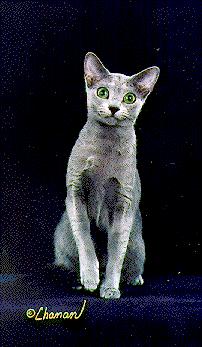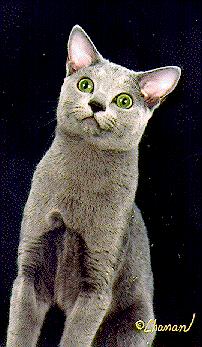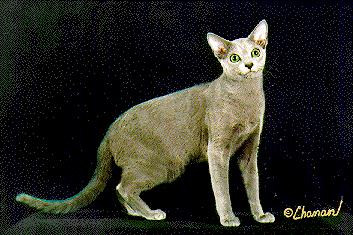Essence of the Russian
Blue
The Russian Blue is an extremely distinctive cat with green eyes and a
blue double coat frosted with silver. However there are many other
subtle distinctions which distinguish it from all other cats:
7 planes: Probably the next
most distinguishing feature that people think of when they think about a
Russian Blue is the 7 planes in the head.  Everyone
knows they are there however we are frequently asked exactly where they
are. A plane is a straight line in the head that put together
creates the whole -- and they cannot be parallel. And the standard is a
little misleading in that it talks about 7 planes in the head -- it is
really 7 planes in the face. The seven planes are:
Everyone
knows they are there however we are frequently asked exactly where they
are. A plane is a straight line in the head that put together
creates the whole -- and they cannot be parallel. And the standard is a
little misleading in that it talks about 7 planes in the head -- it is
really 7 planes in the face. The seven planes are:
1 from tip of the nose to the bottom of the chin (vertical)
1 from tip of nose to the forehead (angled)
1 Front of forehead to the neck (flat creating flat tophead)
2 in the muzzle (one angled in on each side of the face)
2 created by the high cheekbones on each side of the face (angled
out and cross the planes in the muzzle).
Cheekbones: The high cheekbones
are a key element in creating the look of the Russian Blue. Their
width provides a place for the large green eyes, the angle at which they
cross the muzzle planes helps create the smiling look of the Russian Blue,
and their height helps modify the wedge to create a look like no
other. Too wide and the head starts to get round and moves the ears
way off to the side; too narrow and they affect the shape, position
and/or size of the eye. The cheekbones are the pivot for the muzzle
and the ears -- they create the balance in the head.
Muzzle: The muzzle of the
Russian Blue has a major influence on how you see the face of the Russian
Blue. If it is too short, the muzzle planes are forced to be very
wide and the head starts to shorten. In turn, this means the
cheekbone plane also needs to be very wide to balance it creating a wide
coarse head or, if the proportion is not maintained, a rounding of the
head as the angles start to disappear. If it is too long, the whole
head starts to narrow as the angle at which the muzzle and cheekbones
cross becomes less obvious to maintain the balance of the modified wedge.
Smile: The muzzle is
accentuated by characteristic pronounced whiskerpads -- these whiskerpads
combined with the crossing of the muzzle and cheekbone planes create the
smile in the Russian Blue face. If the whiskerpads don't have some
body to them, then you get a more severe look to the face and the smile is
less apparent. If the angles at which the muzzle and cheekbone planes
cross is too wide or too narrow, the smile becomes a cartoonish grin
eventually disappearing or more and more severe eventually disappearing.
 Eyes:
A Russian Blue's eyes mesmerize people when they are right -- there is
something about the glowing emerald green jewels that fascinates people
and draws them to the Russian Blues. The darker the eye color the
better although it can range from a grass green through deep, dark
emerald. The eye should be large and almost round -- just a slight
oriental shape to stop it from being totally round. The eyes should
also be centered so that a line drawn from the tip of the ear to the
muzzle will pass through the center of the eye. They should be
centered in the dimensions created by the profile the cheekbone, the
crossing of the muzzle and the ear plane. When other proportions are
wrong, the Russian Blue's eyes are often affected. If the area to
hold the eye is too small, the eye will be small to fit within the
allotted space or it will seem more oriental in shape and start to tilt to
fit into the area available.
Eyes:
A Russian Blue's eyes mesmerize people when they are right -- there is
something about the glowing emerald green jewels that fascinates people
and draws them to the Russian Blues. The darker the eye color the
better although it can range from a grass green through deep, dark
emerald. The eye should be large and almost round -- just a slight
oriental shape to stop it from being totally round. The eyes should
also be centered so that a line drawn from the tip of the ear to the
muzzle will pass through the center of the eye. They should be
centered in the dimensions created by the profile the cheekbone, the
crossing of the muzzle and the ear plane. When other proportions are
wrong, the Russian Blue's eyes are often affected. If the area to
hold the eye is too small, the eye will be small to fit within the
allotted space or it will seem more oriental in shape and start to tilt to
fit into the area available.
Eye Color: Deep emerald green
is the aim of every Russian Blue breeder although all shades from grass
green through emerald are acceptable. The eye color develops
differently in different lines and allowance is made for some yellow in
the eye up to 10 months. Some lines need all 10 months (and
sometimes more), others are fortunate in that the eye color is fully
emerald green at 4 months.
Flat tophead: A flat tophead is
a characteristic of the Russian Blue -- in fact you can stand a glass on
the top of the heads of my adult males and it will stand (until they start
to object to the affront to their dignity!). Like all kittens,
though, the Russian Blue is born with a round head and the flatness in the
tophead develops with age. Young Russian Blue kittens often exhibit
some degree of kitten doming which flattens as they mature. The flat
tophead should be longer than the profile. 50/50 creates a profile
that is too long and which affects the muzzle and the cheekbones. My
own preference is about 60/40 to 70/30. Once you reach a proportion
of 80/20, the muzzle ends up too short and contributes to a rounder
head rather than the modified wedge.
Profile: The length of the
profile depends on the other planes in the head but it must be straight.
The muzzle and cheekbone planes position the nose and the  profile
draws a straight line from the nose tip to the front of the flat
forehead. The longer the profile, the more likely it will
ripple. The shorter, the more likely it will be straight.
Again, Russian Blue kittens are rarely born with straight profiles.
The skin is often in place for the straight profile and in a young kitten
you can get a better view of the profile by gently pulling back on the
loose skin on the top of the head.
profile
draws a straight line from the nose tip to the front of the flat
forehead. The longer the profile, the more likely it will
ripple. The shorter, the more likely it will be straight.
Again, Russian Blue kittens are rarely born with straight profiles.
The skin is often in place for the straight profile and in a young kitten
you can get a better view of the profile by gently pulling back on the
loose skin on the top of the head.
Nose Tip: Another pivot point
for the head proportions as it provides the end of the profile plane and
starts the vertical plane that goes from the tip of the nose the chin in a
straight line. If this line is wrong, then the whole jaw structure
will be wrong as well.
Ears: We've discussed the 7
planes that are in the face. The ears form another pair of planes
framing the face. They should be large and balance the head. A
good proportion is when the width of the base is almost equal to the
height of the ear. The ear should be set as much on the side of the
head as on the top, creating a frame for the smiling face. It is
sometimes said that the Russian Blue ear can never be too large -- in
general this is true as long as the proportions are maintained. If
the ear is exceedingly large, the base must also be wide to create the
right proportions otherwise you end up with a large narrow ear that looks
a bit like a jack rabbit. If the ear is very large, and the base
proportion is maintained then the head needs to be big enough to
accommodate the ear which can result in a coarse head and of course a
correspondingly large body to balance the head. The key to the
Russian Blue is balance so the ears should be large but not
disproportionately so otherwise they will destroy the balance of the head
and elegant look.
Neck: A neck is a neck is a
neck, you say? Well, not quite. The Russian Blue neck is
another plane that squares off the back of the head dropping down from the
flat tophead to meet the elegant shoulders. The neck should be long
however it should look short or even almost nonexistent due to the density
of the coat and the height of the shoulder blades.
 Shoulders and Leg Line:
The Russian Blue's shoulder blades should be high and there should be
length between them and the top of the leg. The shoulder blade is
also angled in such a way that you can draw a line from the top of the
shoulder down through the leg to the paw. The elegant long line is
very characteristic of the breed and pictures often show the length.
Shoulders and Leg Line:
The Russian Blue's shoulder blades should be high and there should be
length between them and the top of the leg. The shoulder blade is
also angled in such a way that you can draw a line from the top of the
shoulder down through the leg to the paw. The elegant long line is
very characteristic of the breed and pictures often show the length.
Boning and Body Structure: The
Russian is a medium-sized cat with a foreign body structure and fine
boning. The elegant body should be covered with solid muscle giving
good weight to the body. It should never be tubular or light in
weight--nor should it feel fragile in your hands. Again, balance
comes into play in determining the boning. The larger the cat, the heavier
the boning has to be to balance and support the rest of the body
structure. A large cat with really fine boning feels fragile and you
think it may break in your hands. A small cat can have fine boning
however small Russians tend to have short bodies and shorter legs so you
don't get the dramatic foreign body length and long legs. The
medium-sized cat can carry body length and leg length with fine boning in
proportion.
Coat and Color: The Russian Blue
coat is soft, short and thick. It is a non-resilient coat (that is, it
doesn't snap back into place when brushed against the lay of the coat) and
you can draw a pattern in the coat and have it stay in place. It is
solid medium-blue in color and every hair is tipped with silver so that the
coat shimmers like watered silk in the sun. Lighter shades of medium
blue are prized however the base blue should not become so pale that the
distinction between tipping and base coat is lost. Kittens may have
ghost tabbying (usually mackerel) however this fades as the cats mature
resulting in the clear unmarked coat.
 profile
draws a straight line from the nose tip to the front of the flat
forehead. The longer the profile, the more likely it will
ripple. The shorter, the more likely it will be straight.
Again, Russian Blue kittens are rarely born with straight profiles.
The skin is often in place for the straight profile and in a young kitten
you can get a better view of the profile by gently pulling back on the
loose skin on the top of the head.
profile
draws a straight line from the nose tip to the front of the flat
forehead. The longer the profile, the more likely it will
ripple. The shorter, the more likely it will be straight.
Again, Russian Blue kittens are rarely born with straight profiles.
The skin is often in place for the straight profile and in a young kitten
you can get a better view of the profile by gently pulling back on the
loose skin on the top of the head.  Shoulders and Leg Line:
The Russian Blue's shoulder blades should be high and there should be
length between them and the top of the leg. The shoulder blade is
also angled in such a way that you can draw a line from the top of the
shoulder down through the leg to the paw. The elegant long line is
very characteristic of the breed and pictures often show the length.
Shoulders and Leg Line:
The Russian Blue's shoulder blades should be high and there should be
length between them and the top of the leg. The shoulder blade is
also angled in such a way that you can draw a line from the top of the
shoulder down through the leg to the paw. The elegant long line is
very characteristic of the breed and pictures often show the length.